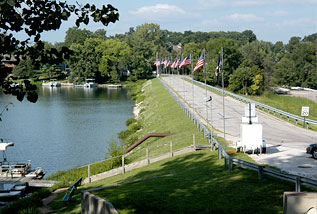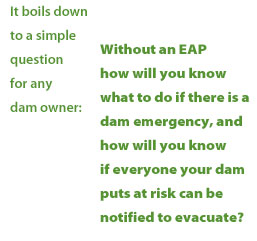Dam Owner Responsibilities
Liability and Legal Considerations
The records of the Texas Commission on Environmental Quality (TCEQ) Dam Safety Program indicate that in recent years there have been 2, 3 or more dam failures in Texas each year. Many of these
result in catastrophic impact on communities, private property,
and public works downstream, including loss of life. No dam owner
wants that calamity to involve his dam.
Owner liability varies from state to state depending on statutes, regulations and case law. However, the concept of strict liability falls heavily on the dam owner for damages regardless of the cause of the failure. Also liable are the many organizations in Texas that are responsible for operating and maintaining a dam, including watershed conservation districts, city and county governments, and special purpose districts. The Texas dam safety law and the regulations that implement it specifically absolve the state from liability from damages caused by a dam failure.
Learn Owner Liability
When assessing the liability of the owner and the potential for negligence, the standard of care the dam owner should have taken will be weighed against the downstream hazards. Compliance with government regulations and professional standards, such as the responsibility of dam owners to prepare EAPs on their HHP dams, establishes a minimum standard of care to be followed by the owners. The Texas Guidelines for Operation and Maintenance of Dams notes that "A carefully conceived and implemented Emergency Action Plan is one positive step you, the dam owner, can take to accomplish dam safety objectives and to protect your investment and reduce potential liability."
ASDSO notes that to manage risks and control potential loss an owner will need to provide employee training, regular maintenance, emergency preparedness, and liability insurance. Each HHP dam should have:
- A state dam safety permit.
- An operation plan, documented regular maintenance plan, and Emergency Action Plan.
- Documented periodic inspections.
- Warning signs and controlled access.

The Owner, Not the State, is Liable
Laws pertaining to Texas dam safety are found in the Texas Administrative Code, Title 30, Part 1, Chapter 299. Portions pertaining specifically to dam owner liability are in Rule 299.41:
- The owner shall be responsible for operating and maintaining the dam and appurtenant structures in a safe manner.
- The owner shall be responsible for addressing all maintenance and safety concerns at the dam and appurtenant structures identified during any inspections conducted by the executive director or the owner.
- The owner shall ensure that necessary maintenance, repairs, alterations, or modifications are initiated and completed in a timely manner following any inspection.
- Nothing in this chapter or in orders issued by the commission shall be construed to relieve an owner of a dam or reservoir of the legal duties, obligations, or liabilities incident to ownership or operation.
Who Are Dam Owners?
The Texas dam safety regulations define as a dam owner any person who can be one or more of the following:
- Holds legal possession or ownership of an interest in a dam;
- Is the fee simple owner of the surface estate of the tract of land on which the dam is located if actual ownership of the dam is uncertain, unknown, or in dispute unless the person can demonstrate by appropriate documentation, including a deed reservation, invoice, bill of sale, or by other legally acceptable means that the dam is owned by another person or persons;
- Is a sponsoring local organization that has an agreement with the Natural Resources Conservation Service for a dam constructed under the authorization of the Flood Control Act of 1944 (as amended), Public Law 78-534, the Watershed Protection and Flood Prevention Act, 1954 (as amended), Public Law 83-566, the pilot watershed program under the Flood Prevention of the Department of Agriculture Appropriation Act of 1954, Public Law 156-67, or Subtitle H of Title XV of the Agriculture and Flood Act of 1981, the Resource Conservation and Development Program; or
- Has a lease, easement, or right-of-way to construct, operate, or maintain a dam
